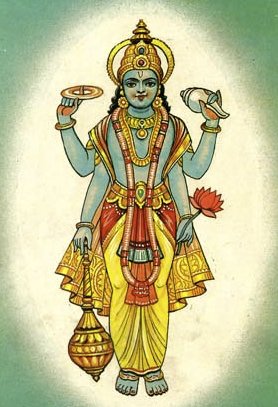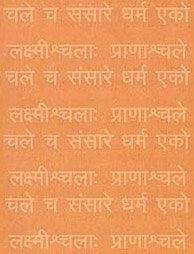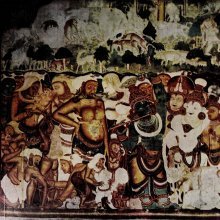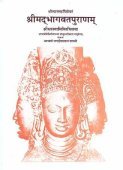Gopi, Gopī: 14 definitions
Introduction:
Gopi means something in Hinduism, Sanskrit, Buddhism, Pali, Hindi, biology. If you want to know the exact meaning, history, etymology or English translation of this term then check out the descriptions on this page. Add your comment or reference to a book if you want to contribute to this summary article.
Images (photo gallery)
In Hinduism
Purana and Itihasa (epic history)
Source: Cologne Digital Sanskrit Dictionaries: The Purana IndexGopi (गोपि).—(girls) see Kātyāyani vrata. The gopi women were enchanted by the music of Kṛṣṇa, took to Brindāvana, and worshipped him. By singing his glories and through kāma they became one with Him.1 On another occasion they were so much moved by his music that they left their household work, children and male members and came to Brindāvan. Though they were asked to go back they refused, and desired to attain His feet. While they were enjoying his presence, Kṛṣṇa suddenly disappeared. They wandered all the forest in search of Him, addressing all trees and plants as to his whereabouts. During all this time each thought that every one of them was Kṛṣṇa and imitated his boyish exploits. After vain search they came to the very place wherefrom they started and meditated on his greatness. They praised him in the form of gīta looking forward to his arrival. Soon he was in their midst and consoled them. They took part in the rāsa krīḍa where was seen a Kṛṣṇa between every two women. They sang and danced unconscious of the loosening of their jewels, braid or clothes. When they sweated in fatigue, Kṛṣṇa wiped off their sweat. They then enjoyed water-sports, and sports on the river-banks in the upavana. By dawn they repaired to their homes.2 When some gopis were forcibly taken by Śankha Cūda, Kṛṣṇa released them and killed him.3 When Kṛṣṇa was away in the woods, the gopis who were at homes sang in praise of his veṇu gītā.4 Gopis heard of Kṛṣṇa going to Mathrā with Akrūra and characterised Akrūra to be only a Krūra as he brought about Kṛṣṇa's separation from them. They turned their minds on the past deeds of Kṛṣṇa, and stood motionless as pictures at his leaving them. Kṛṣṇa assured them of his return soon.5 Uddhava was sent by Kṛṣṇa with a message to gopis and gopas. The gopis mistook his chariot for that of Akrūra. They all surrounded him and enquired of Kṛṣṇa and his attitude towards them. Uddhava brought relief to them by delivering Kṛṣṇa's message while they recounted to him his deeds at Brindāvan. Pleased at their attachment to the Lord, Uddhava took leave of them after spending some time there.6 They went to Syamantapañcaka and met Kṛṣṇa who took them aside and consoled them so much so that they were all in contemplation of Him. Left for Mathurā.7 and attained salvation by satsaṅga.8
- 1) Bhāgavata-purāṇa X. 21. 7-20.
- 2) Ib. chaps. 29-33.
- 3) Ib. 34. 24-32.
- 4) Ib. 35 (whole).
- 5) Ib. 39. 13-32.
- 6) Ib. 46. 48, and ch. 47 whole.
- 7) Ib. 82. 40-49; 84. 69.
- 8) Ib. XI. 12. 6; VII. 1. 30.

The Purana (पुराण, purāṇas) refers to Sanskrit literature preserving ancient India’s vast cultural history, including historical legends, religious ceremonies, various arts and sciences. The eighteen mahapuranas total over 400,000 shlokas (metrical couplets) and date to at least several centuries BCE.
Vaishnavism (Vaishava dharma)
Source: Prabhupada Books: Sri Caitanya CaritamrtaGopī (गोपी, “damsel”).—According to Śrī Caitanya Caritāmṛta, Madya-lila 9.135, “Lord Kṛṣṇa belongs to the cowherd community, and the gopīs are the dearmost lovers of Kṛṣṇa. Although the wives of the denizens of the heavenly planets are most opulent within the material world, neither they nor any other women in the material universe can acquire Kṛṣṇa’s association”.
Source: Pure Bhakti: Bhagavad-gita (4th edition)Gopī (गोपी) refers to “a transcendental cowherd maiden of Vraja”. (cf. Glossary page from Śrīmad-Bhagavad-Gītā).
Source: Pure Bhakti: Bhajana-rahasya - 2nd EditionGopī (गोपी) or Gopikā refers to:—A cowherd girl or woman of Vraja. (cf. Glossary page from Bhajana-Rahasya).
Source: Pure Bhakti: Brhad BhagavatamrtamGopī (गोपी) refers to:—A young cowherd maiden of Vraja. The gopis, headed by Śrī Rādhā, who serve Kṛṣṇa in the mood of amorous love and represent the epitome of unalloyed devotion to Kṛṣṇa. Gopi may also refer to the senior gopis headed by Mother Yaśodā, who serve Kṛṣṇa in the mood of parental affection. (cf. Glossary page from Śrī Bṛhad-bhāgavatāmṛta).

Vaishnava (वैष्णव, vaiṣṇava) or vaishnavism (vaiṣṇavism) represents a tradition of Hinduism worshipping Vishnu as the supreme Lord. Similar to the Shaktism and Shaivism traditions, Vaishnavism also developed as an individual movement, famous for its exposition of the dashavatara (‘ten avatars of Vishnu’).
Vedanta (school of philosophy)
Source: Shodhganga: Siva Gita A Critical StudyGopī (गोपी) or Gopīgītā refers to one of the sixty-four Gītās commonly referred to in Hindu scriptures.—Gītā is the name given to certain sacred writings in verse (often in the form of a dialogue) which are devoted to the exposition of particular religious and theosophical doctrines. Most of these Gītās [i.e., Gopī-gītā] originate from the Mahābhārata or the various Purāṇas.

Vedanta (वेदान्त, vedānta) refers to a school of orthodox Hindu philosophy (astika), drawing its subject-matter from the Upanishads. There are a number of sub-schools of Vedanta, however all of them expound on the basic teaching of the ultimate reality (brahman) and liberation (moksha) of the individual soul (atman).
Biology (plants and animals)
Source: Google Books: CRC World Dictionary (Regional names)Gopi in India is the name of a plant defined with Ichnocarpus frutescens in various botanical sources. This page contains potential references in Ayurveda, modern medicine, and other folk traditions or local practices It has the synonym Echites affinis Roem. & Schult. (among others).
Example references for further research on medicinal uses or toxicity (see latin names for full list):
· Prodr. (DC.) (1844)
· Botanische Jahrbücher für Systematik, Pflanzengeschichte und Pflanzengeographie (1927)
· Obs. Pl. Nov. (1871)
· Journal of Botany (1923)
· The Flora of Tripura State. (1981)
· Fl. Indo-Chine
If you are looking for specific details regarding Gopi, for example diet and recipes, side effects, pregnancy safety, chemical composition, health benefits, extract dosage, have a look at these references.

This sections includes definitions from the five kingdoms of living things: Animals, Plants, Fungi, Protists and Monera. It will include both the official binomial nomenclature (scientific names usually in Latin) as well as regional spellings and variants.
Languages of India and abroad
Pali-English dictionary
Source: BuddhaSasana: Concise Pali-English Dictionarygopī : (f.) a woman herding the cows or the wife of a cowherd.

Pali is the language of the Tipiṭaka, which is the sacred canon of Theravāda Buddhism and contains much of the Buddha’s speech. Closeley related to Sanskrit, both languages are used interchangeably between religions.
Sanskrit dictionary
Source: Cologne Digital Sanskrit Dictionaries: Edgerton Buddhist Hybrid Sanskrit DictionaryGopī (गोपी) or Gopā.—q.v.: Mahāvyutpatti 1071 v.l. for Gopā (but Mironov only Gopā, no v.l.); as the Bodhisattva's wife, Gopi (voc.) Lalitavistara 235.22; 237.11 (both verses).
Source: Cologne Digital Sanskrit Dictionaries: Monier-Williams Sanskrit-English Dictionary1) Gopī (गोपी):—[=go-pī] [from go-pa] a f. idem, [cf. Lexicographers, esp. such as amarasiṃha, halāyudha, hemacandra, etc.]
2) [v.s. ...] ([Vopadeva iv, 22]; cf. [Pāṇini 4-1, 48]) a cowherd’s wife, [Hitopadeśa ii, 7, 0/1]
3) [v.s. ...] a cow-herdess, milkmaid ([especially] the cowherdesses of Vṛndāvana, companions of Kṛṣṇa’s juvenile sports, considered sometimes as holy or celestial personages; cf. [Religious Thought and Life in India] pp. 113 and 136), [Mahābhārata ii, 2291; Harivaṃśa 4098; Bhāgavata-purāṇa; Gīta-govinda]
4) [v.s. ...] a protectress, female guardian, [Raghuvaṃśa iv, 20] (ifc.)
5) [v.s. ...] = prakṛti, nature, [Kramadīpikā]
6) [v.s. ...] Abrus precatorius, [cf. Lexicographers, esp. such as amarasiṃha, halāyudha, hemacandra, etc.] (cf. ahi-, indra-, kula-, tridaśa-, vāta-, surendra-.)
7) [from go-pa] b f. of pa q.v.
Source: DDSA: Paia-sadda-mahannavo; a comprehensive Prakrit Hindi dictionary (S)Gopī (गोपी) in the Sanskrit language is related to the Prakrit word: Govī.
Sanskrit, also spelled संस्कृतम् (saṃskṛtam), is an ancient language of India commonly seen as the grandmother of the Indo-European language family (even English!). Closely allied with Prakrit and Pali, Sanskrit is more exhaustive in both grammar and terms and has the most extensive collection of literature in the world, greatly surpassing its sister-languages Greek and Latin.
Hindi dictionary
Source: DDSA: A practical Hindi-English dictionaryGopī (गोपी):—(nf) a cowherd’s wife.
...
Kannada-English dictionary
Source: Alar: Kannada-English corpusGōpi (ಗೋಪಿ):—
1) [noun] = ಗೋಪಿಚಂದನ [gopicamdana].
2) [noun] a woman belonging to cowherd family or caste.
3) [noun] the creeper Ichnocarpus frutescens of Apocynaceae family; black creeper.
4) [noun] the pale or whitish yellow colour.
Kannada is a Dravidian language (as opposed to the Indo-European language family) mainly spoken in the southwestern region of India.
Nepali dictionary
Source: unoes: Nepali-English DictionaryGopī (गोपी):—n. fem. cowherdess; cowherd's wife;
Nepali is the primary language of the Nepalese people counting almost 20 million native speakers. The country of Nepal is situated in the Himalaya mountain range to the north of India.
See also (Relevant definitions)
Starts with (+38): Gopi-baans, Gopi-bamsa, Gopicandana, Gopicandanamahatmya, Gopicandanopanishad, Gopicandra, Gopichandana, Gopida, Gopigita, Gopijala, Gopijana, Gopijanavallabhacaranaikatana, Gopika, Gopikagita, Gopikanta, Gopikasaras, Gopike, Gopikkuri, Gopila, Gopin.
Ends with: Candanagopi, Ekopi, Kalamagopi, Mahagopi, Mumgopi, Nityasiddhagopi, Shaligopi, Yashogopi.
Full-text (+89): Gopicandana, Gopika, Mandalanritya, Gopigita, Gopinatha, Gopis, Gopiramana, Rasalila, Kalamagopi, Gopi-baans, Radha, Shaligopi, Bess, Kelivriksha, Ugratapas, Gopicandanopanishad, Gopike, Gopinathasaptashati, Gopirasavivarana, Rasakrida.
Relevant text
Search found 68 books and stories containing Gopi, Gopī, Go-pi, Go-pī, Gōpi; (plurals include: Gopis, Gopīs, pis, pīs, Gōpis). You can also click to the full overview containing English textual excerpts. Below are direct links for the most relevant articles:
Garga Samhita (English) (by Danavir Goswami)
Verse 2.23.35 < [Chapter 23 - The Killing of Śaṅkhacūḍa During the Rāsa-dance Pastime]
Verse 5.18.26 < [Chapter 18 - Uddhava Hears the Gopīs’ Words and Returns to Mathurā]
Verse 2.23.37 < [Chapter 23 - The Killing of Śaṅkhacūḍa During the Rāsa-dance Pastime]
Sahitya-kaumudi by Baladeva Vidyabhushana (by Gaurapada Dāsa)
Text 5.10 < [Chapter 5 - Second-rate Poetry]
Text 4.24 < [Chapter 4 - First-rate Poetry]
Text 9.9 < [Chapter 9 - Ornaments of Sound]
Brihad Bhagavatamrita (commentary) (by Śrī Śrīmad Bhaktivedānta Nārāyana Gosvāmī Mahārāja)
Verse 1.7.157-158 < [Chapter 7 - Pūrṇa (pinnacle of excellent devotees)]
Verse 1.1.5 < [Chapter 1 - Bhauma (the earthly plane)]
Verse 1.7.39-40 < [Chapter 7 - Pūrṇa (pinnacle of excellent devotees)]
Tiruvaymoli (Thiruvaimozhi): English translation (by S. Satyamurthi Ayyangar)
Introduction to Section 5.6 < [Section 6 - Sixth Tiruvaymoli (Katal-nalam ceytenum)]
Pasuram 10.3.9 < [Section 3 - Third Tiruvaymoli (Vey maru tol inai)]
Pasuram 4.2.2 < [Section 2 - Second Tiruvaymoli (Palan ay, El ulaku untu)]
Hari-bhakti-kalpa-latikā (by Sarasvati Thkura)
Śrī Kṛṣṇa-vijaya (by Śrī Gunaraja Khan)
Related products







